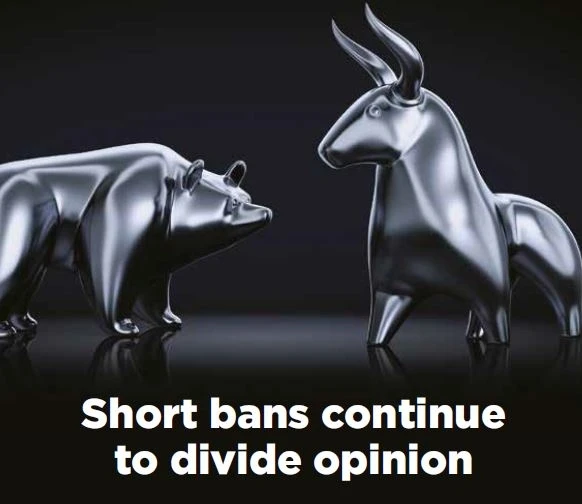
Market participants reflect on how Asian regulators responded to calls for a relaxation of short selling bans – and how they have been impacted by disparities across different Asian markets.
[This article is part of the Asia Pacific Securities Finance Guide 2022, available here.]
In last year’s guide we reported that more than 12 months on from the outbreak of the Covid pandemic, many of the ‘temporary’ short selling bans imposed by Asian national regulators in early 2020 remained in place despite calls from trade associations and securities financiers to have them lifted.
Some of the strongest criticism of these bans came from the Pan-Asia Securities Lending Association (PASLA). In its 2021 review of the regional securities lending market, the association noted that the short selling bans around the region that had impacted the growth of the market had been brought to an end – or at least relaxed – and said it was encouraging to see the industry moving on from that restrictive environment. However, it also observed that these disruptions meant that many anticipated new developments had taken a back seat at least temporarily.
One interesting development that did emerge over the last 12 months was China’s decision to authorise insurers to take part in securities lending, potentially boosting shortselling activity. A report from Reuters in December noted that the China Banking and Insurance Regulatory Commission (CBIRC) had published rules allowing insurers to participate in securities lending. The CBIRC stated that this would help insurers improve returns on their long term and sizable stock and bond holdings as well as improving market liquidity. Chinese insurers hold trillions of yuan worth of bonds, stocks and securities funds.
China catalyst
Elsewhere in Asia Pacific, China’s regulatory clampdown on a number of domestic sectors including technology, private education, gaming and most notably property were all catalysts for healthy short interest in Hong Kong and beyond.
"In the Philippines there is a pending regulatory change to allow offshore collateral to be accepted and to recognise the industry standard GMSLA." (Adnan Hussain, HSBC)
Of the jurisdictions that announced bans, Malaysia announced in March 2020 that intraday short selling, regulated short selling and intraday short selling by proprietary day traders would be suspended temporarily. The suspension for regulated short selling was lifted on 1 January 2021, but remained in place for intraday short selling until the end of last year.
The ban on short selling was not unique – South Korea implemented a similar ban in the aftermath of the 2008 global financial crisis – although it was extended in that country multiple times into 2021 and only partially lifted in May 2021 for the country’s largest stocks on the KOSPI 200 and KOSDAQ 150. In March 2020 the Indonesia Stock Exchange (IDX) placed a temporary ban on short selling and stated that it would not be publishing a list of stocks eligible for short selling until further notice. Under normal circumstances local brokers are allowed to short sell with the IDX publishing the list of securities eligible for short selling and margin trading on the last trading day of each month.
From an asset class perspective, increasing demand to borrow ETFs was particularly prevalent in those that tracked emerging market indices (where traditional securities lending is not supported) or those tracking high yield corporate debt indices. This asset provided an efficient mechanism of capturing broad based short exposure, especially in periods of heightened market volatility.
Key pipelines
Key pipelines include mainland China and the Philippines, where the market continues to see positive updates to lending or short selling guidelines and regulators have taken significant steps to engage the market in efforts to enhance the guidelines and to promote increased activity. “In the Philippines there is a pending regulatory change to allow offshore collateral to be accepted and to recognise the industry standard Global Master Securities Lending Agreement (GMSLA),” explains Adnan Hussain, global head of securities lending at HSBC. “It also announced the intended launch of rules and regulations for short selling.”
Bans controversial
In response to the question of whether these bans served their purpose, John Moran, head of securities finance business development at BNY Mellon says that based on everything we have seen and learned in the space, short selling bans rarely achieve the purpose that people think they should achieve.
“Bans are usually enacted only during extreme periods of market risk or volatility caused by extreme economic or geopolitical events,” he says. “By the very nature of the many factors involved, there is no way of empirically demonstrating the true effect that a short sell ban has on a security or index.”
From past industry and independent research, Morgan says it is possible to observe that short sell bans do little to stop the slide in stock prices, significantly increase costs of liquidity, and are detrimental for liquidity - especially for stocks with small capitalisation and no listed options.
“We have also learned that they have a slow price discovery, do not achieve any certainty regarding reducing return volatility, and can have negative spillover effects in alternative OTC products/markets, especially for emerging markets,” he adds. “At the start of the pandemic, the three APAC markets to ban short selling were South Korea, Malaysia, and Indonesia. With the massive quantitative easing and support that all central banks and governments enacted during 2020 and 2021, it is nearly impossible to say whether the bans in isolation served their purpose.”
Andrew McCardle, head of EquiLend Asia agrees that short selling bans in Asia were controversial as there was disagreement in the market about whether it would result in the stability which the regulators looked to secure with the decision. In fact, it was argued by market participants that it could bring greater volatility and even once the regulators were convinced, the bans were lifted at varied paces for a range of reasons.
“Those regions which implemented short selling bans find a significant portion of ownership stocks weighted to retail investors, a factor that regulators in the West do not worry about nearly as much,” he says. “Retail investors in Asian markets can exceed 30% of the market, which can mean that market regulators feel compelled to protect those investors.”
In recent years the retail sector has had a negative view on short selling and as such, in some areas, while the bans were not appreciated by the institutional investors, the retail sectors of the market were more favourable.
Flow factors
The disparate regulatory nature of Asia meant that while bans were put in place by some regulators, not all countries followed suit and therefore the focus of activity flowed according to where short selling was possible. An example was the growth in trading in Taiwan once the short selling ban was lifted.
“Prior to the short selling bans, while a key market of the region, Taiwan was less significant from a revenue generating perspective by comparison to Korea,” explains McCardle. “However, it is now a larger revenue market due to the earlier removal of the short selling ban and because it did not lift the ban with limitations. Korea set limitations that only a small subset of shares may be shorted.”
McCardle observes that since there is rarely a single reason for imposing bans, it is difficult to tell if they achieved their purpose.
“Certainly, they demonstrated to retail investors that their concerns around market volatility were understood, offering reassurance there,” he adds. “As a measure for minimising market volatility, comparable markets without bans performed similarly, so for short selling bans as a safety lever in volatile times the impact is inconclusive.”
According to McCardle it is also difficult to say definitively whether markets where the ban was lifted early performed better than those where the regulator was slow to reintroduce short selling. “I would hazard against using data from such a short period of time as a benchmark for success in supporting or undermining short selling bans,” he says. “Certainly, agent lenders or beneficial owners looking at revenue would see better performance in markets where the ban was lifted sooner, as the lending volume and revenue will have returned sooner to those markets.”
Comparing Taiwan and Korea, for example, we see that the general performance of the benchmark indices for the two markets tracked roughly the same trend over the period of the ban. Bans were implemented in March 2020 and lifted in June 2022 and May 2021 respectively.
“For less established markets like Malaysia and Indonesia where short sell bans were implemented, it is harder again to assess the impact on performance,” adds McCardle. “As less established markets with generally less flow from a securities borrowing and lending perspective, the impact of the bans compared to those in more established markets in a time of crisis is difficult to discern.”
Performance factors
The above observations underline the challenge of isolating the impact of short selling bans from other factors impacting market performance.
“Assessing the impact of one measure in market control is difficult at the best of times,” acknowledges McCardle. “While we can look at other similar markets in the region that did not implement a short selling ban and observe that they performed as well, better, or worse, we can only infer what that may have meant to other markets as the factors are all slightly different in normal times.”
"Prior to the short selling bans...Taiwan was less significant from a revenue generating perspective than Korea. However, it is now a larger due to the earlier removal of the short selling ban...with no limitations." (Andrew McCardle, EquiLend Asia)
Reviewing the operating conditions of the last few years, the combination of the global impact from the pandemic, geopolitical stressors and the introduction of new regulation, in addition to short selling bans, creates an impossible comparison point from which to assess impact. It is also important to recognise the differing views around the intersection between short selling and securities lending and how these might impact how securities finance is viewed through an ESG lens suggests Simon Kellaway, Greater China and North Asia head of the financing & securities services team at Standard Chartered.
“On one hand, securities lending is important as it brings liquidity and price discovery to capital markets generally and enhanced returns to investors who lend,” he says. “On the other, securities lending can be intrinsically linked to short selling and can be perceived negatively by those who are less familiar with its broad benefits.”
In April it was reported that the Oman Capital Market Authority was preparing to authorise the use of short selling for the first time to attract new market makers and boost liquidity in the sultanate’s capital market. Haitham bin Salim al Salmi, CEO of Muscat Stock Exchange was quoted in local media as saying that plans for the authorisation of short selling would be announced soon and that it would be enabled alongside the introduction of securities lending and borrowing.
This article is part of the Global Investor Asia Pacific Securities Finance Guide 2022, and if you want to download the full guide click here.


